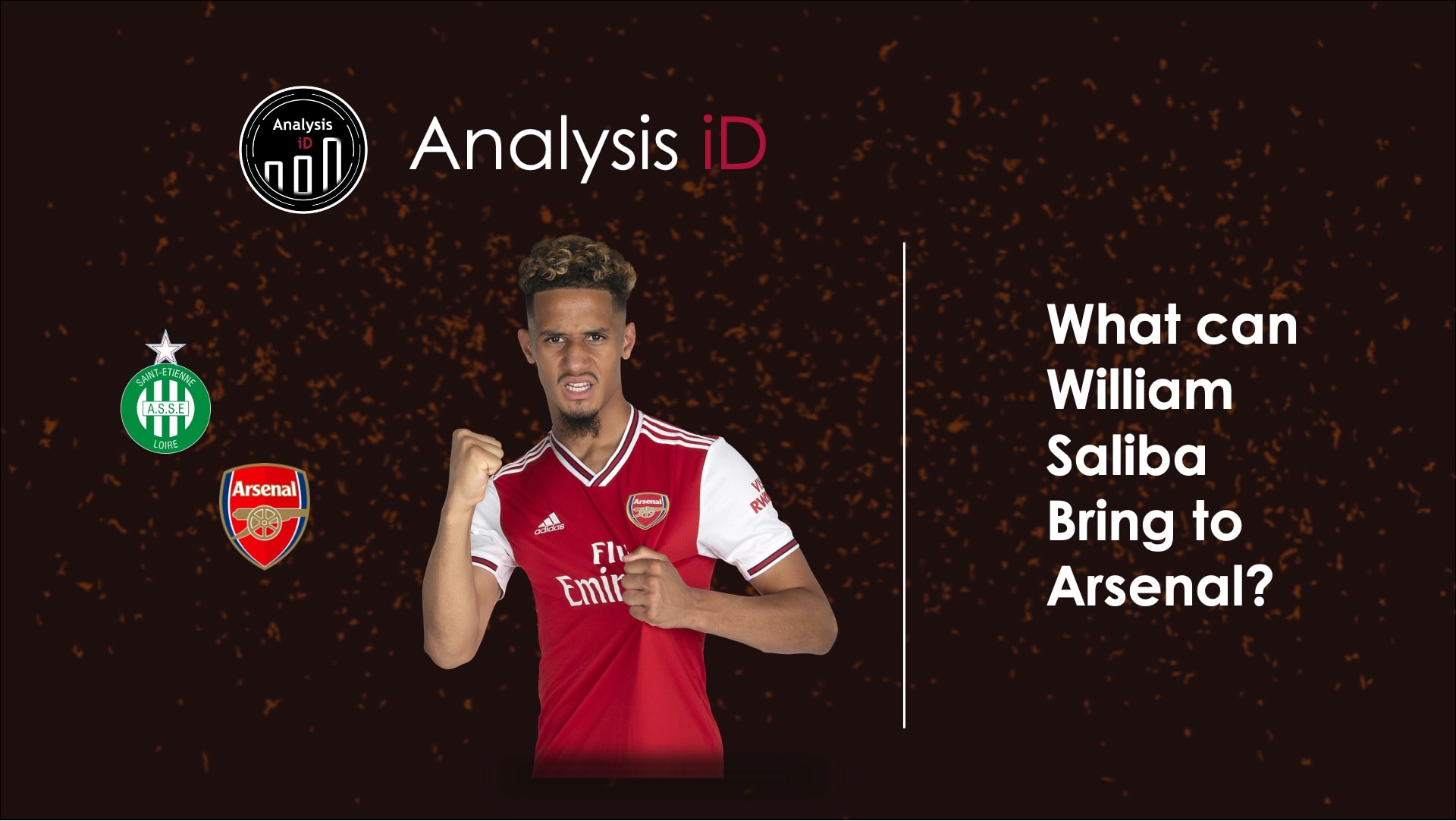A dive into the video to see what the young Frenchman can bring to Arsenal
INTRO
I wrote recently about Arsenal’s struggles when it comes to the recruitment of Centre Backs (Part 1 here & Part 2 here). There seemed to be a turning point post the departure of Sol Cambell in 2006, where Arsenal had a very consistent specific type of Centre Back that they wanted at the club (small-ish by modern standards, mobile, good on the ball, defends on the front-foot) and often paired two of this type of defender together to… I believe the polite term is “mixed success”.
The signing of William Saliba in July 2019 seemed to be a welcome move away from this profile. To be fair to Arsenal, the arrival of Dinos Mavropanos the year previous appeared to hint at this also – though Arsenal fans will hope Saliba will have more of an impact at the club than the big Greek defender has or looks likely to do.
Some initial data analysis comparing defenders in the big 5 leagues for Aerial and Ground Duel Success had Saliba profiling brilliantly, comparable to star names like Virgil Van Dijk, Raphael Varane and Matijas De Ligt, amongst others. What this data suggests, is that when he attempts a ground or aerial duel with opponent, he comes out on top… a lot.

I thought it would be interesting to see if we could apply some context to the data and see if Saliba was really as good as the model was suggesting.
I chose a recent game against Bordeaux to analyse and my thoughts are below. Did I choose this particular game to cast a glancing eye over the star of Netflix’s dark comedy Sunderland ‘Til I Die, Josh Maja? I prefer not to speak.

VIDEO ANALYSIS
STRENGTHS
Within 5 or 10 minutes, it’s not difficult to see what convinced Arsenal to pay a reported £27m for the then 18-year-old.
What strikes you initially, beyond his impressive physical stature, is his composure. Saliba really breaks the mold of Arsenal’s front-foot, impetuous style of defender. Happy to play more on the back foot, the Frenchman is patient with his tackling and urge to intercept. There’s not a single slide tackle in anger in 96 minutes, which comes as quite a shock after 3 ½ years of watching Mustafi in red and white.
A theme with Saliba is his patient style of defending. Often he is the deepest centre back, playing a sort of sweeping role. He is able to resist the urge to try and win the ball every time and opposition forward has it. In defensive transition, often, he makes smart decisions to stay on his feet, delay the attack and force the play wide, giving his teammates the chance to recover, as evidenced below.
This is good basics of defending. And shows a level of awareness of what’s around him, and the ability to make quick, and sensible, decisions on the pitch.
Physical Tools
Physically he is very impressive. I think the two short clips below demonstrate his considerable athleticism. The first is an impressive sprint from Saliba, covering a lot of ground with his long strides to ultimately make a block following a set piece and defensive transition. He’s not lightning-quick, but moves well and covers ground quickly when he hits top speed. The data highlighted his prowess in the air, and this is evidenced in the 2nd clip below. He’s a big, athletic guy, and at 6”4 will have a considerable advantage over most forwards he faces when it comes to battling for balls in the air and defending set pieces.
In Possession – Passing
The composure Saliba shows in his defending continues into his in-possession work. He used the ball intelligently, taking few risks, but also demonstrated the ability to make what Wyscout would define as “Smart passes” (progressive, forward, line breaking).
He’s not heavily reliant on being responsible for the buildup. In much the same way Granit Xhaka does for Arsenal, he has one-time Arsenal target Yann M’vila or Mahdi Camara (interesting player, 21 years old) dropping into to form a back 3 in the first phase of possession, with Saint Etienne’s midfield rotation ensuring it is not always the same player in the deepest midfield role. He will also potentially have David Luiz to support him in the buildup but don’t get me wrong, Saliba is good on the ball.
A selection of Saliba’s forward passes are presented below. The pace and detail on the pass in the third clip are superb, passing it to the receivers outside foot, encouraging him to turn out to where he has supporting players on the overlap.
My one criticism of his passing would be, at times, I’d like to see him punch the ball in with a bit more zip. He can do it; I’d just like to see more of it. There is a clear preference to pass the ball with the outside of his right foot, rather than use his left in the game. Though he uses this to good effect, you’d hope this is something he can still develop as he matures.
Dribbling to evade pressure
Ultimately, there are two ways to progress the ball up the pitch: with a pass or with a dribble. On the evidence of this game, Saliba has both options available to him. The Frenchman is very confident with the ball at his feet and uses body feints to dribble and evade pressure. It was pleasing to see he doesn’t fall into the same pitfall as some young ball-playing Centre Backs, who play with a degree of over-confidence and take a few too many unnecessary risks. The Frenchman’s decision making is good and belies his young age, he’ll dribble when he needs to but will move the ball quickly when required also.
WEAKNESSES
Physical development
An obvious one, but at 19, there is an element of Saliba filling out his frame. He’s rarely out-muscled, as evidenced by his proficiency in aerial/ground duels in the data and this video analysis, but you would be confident he could add some more power to his game as he grows into his physique.
For the goal that Saint Ettiene concede, Saliba is out-muscled (to an extent), allowing the Netflix Ronaldo, Josh Maja, to pounce. It’s one of those where he needs to be a stronger, but I would add that when you are airborne, it doesn’t take a huge amount of force to knock you off balance. The old adage play to whistle also applies here. I don’t think it would have changed anything in this instance, but he should be continuing to try and stop the shot, rather than gesticulating to the referee that he was fouled. It’s worth noting that Maja hadn’t really had a sniff up until that point and certainly hadn’t had a chance or shot on goal. Maja himself is an interesting player though, physical and good movement off the ball. Clearly an eye for goal too and a knack of being in the right place at the right time ™.
Experience
As I was reviewing this game, I felt the need to find something around his defending to put in the weaknesses section. I can’t just leave it blank. He’s not perfect, is he?
He’s not perfect, no. I found myself over-analysing a few instances where he was *marginally* out of position. I think over-analysing is the key phrase there. To be honest, if you are having to work that hard to identify weaknesses, it is probably a very good sign. There are no major areas of concern in this performance. He has good game here, doing a lot of things well.
One thing that is a concern for Saliba is his lack of experience. The 19-year-old (as of March) has only played 28 games in Ligue 1 and a handful of cup games – with 5 of his total appearances coming at right back (according to Transfermarkt). I think there are two aspects to consider when it comes to experience:
The most obvious is the theory that the more games you play, the more you learn. Saliba doesn’t yet have this experience at senior level – so won’t have the had the luxury of developing and honing his solutions to problems on the pitch over time. Of course, this will come with games but there may be a few bumps in the road along the way.
The 2nd interesting aspect of experience is the question of whether bad experience is better than a lack of experience. Michael Vaughan, the former England Cricket Captain, spoke about why he left out a lot of experienced players, opting for some fresh faces, before the historic Ashes victory in 2005. Vaughan believed some of his players with more pedigree, had experience against Australia – but that this experience was mostly negative. These players had a lot of psychological baggage, playing in losing teams, getting abuse from opposition fans and generally not experiencing much success in this particular domain. In some ways, I think this applies to Arsenal. Some of the defenders at the club are experienced, but some of that experience has come in fairly chaotic, and not particularly successful, defensive structures.
Ideally, Arsenal would bed Saliba in slowly. I am sure this is something Arteta will look to do initially. It would perhaps be unwise to throw him straight in to starting XI, and better to let him play some cup games and understudy in the Premier League to some of the more experienced heads. You can imagine the fan pressure to see him in the side in the event of a few underperforming appearances from Arsenal’s usual suspects, though. From what I’ve seen, I think the young Frenchman is good enough to have an impact almost straight away.
Mentality
Again, this is one thing that is very difficult to make any kind of judgement on using data or video analysis – how Saliba will cope with the increased pressure and scrutiny at Arsenal will be interesting to see. He certainly has a level of confidence, a swagger, about the way he plays. I would be a shock if he didn’t need time to adapt to a higher level of football and the pressures that come with that. I hope he’s afforded the patience from Arsenal fans that his talent deserves.
‘You pay for the education of young players with points. If I play a 20-year old centre back, I know he’ll cost me points during the season & I have to stand up for that. A less talented 28 year old would cost me less points. However, by 23/24 you have a player.” As Arsene Wenger once said.
The exciting thing for Arsenal fans is that even at his young age and this stage of his development, I’m not sure how much better Arsenal’s more experienced defenders are than him…
SUMMARY
Arsenal fans should be excited. Saliba’s combination of physical and technical tools, coupled with a composure that belies his age is an incredibly promising mix. He is completely different to anything Arsenal have at the club currently. Towering above forwards at 6”4, and with his back-foot, sweeper, style of defending, he seems a natural fit with one of Arsenal’s collection of more positionally aggressive Centre Backs.
He plays as left-sided central defender, the same spot David Luiz occupies for Arsenal. I see no reason he couldn’t play as the RCB, however. It may be at Saint Ettiene, as is quite common, that Saliba is asked to play LCB as he’s the more adept of the CB pair on the ball and can offer the better passing angles from that position. On a side note, Saliba’s defensive partner in the game is 6”3, 20-year-old Wesley Fofana, he looks a really good player as well. The way France are churning out talented Centre Backs is remarkable at the moment…
Anyway, Saliba looks a real top talent. I wouldn’t be surprised to see him have an impact at the club sooner than people think.
And we can only hope that football itself is able to return sooner than people have been speculating.
From a defensive point of view, something for Arsenal fans to be excited about, at last.
Read about my search for a long-term partner for Saliba, here: https://sancho01.wixsite.com/sqanalysis/post/finding-arsenal-s-next-centre-back
Thanks as always for reading.
Sancho Quinn, 26/04/20












